Spotlight on Caitlin O'Hara
Nov 25, 2014
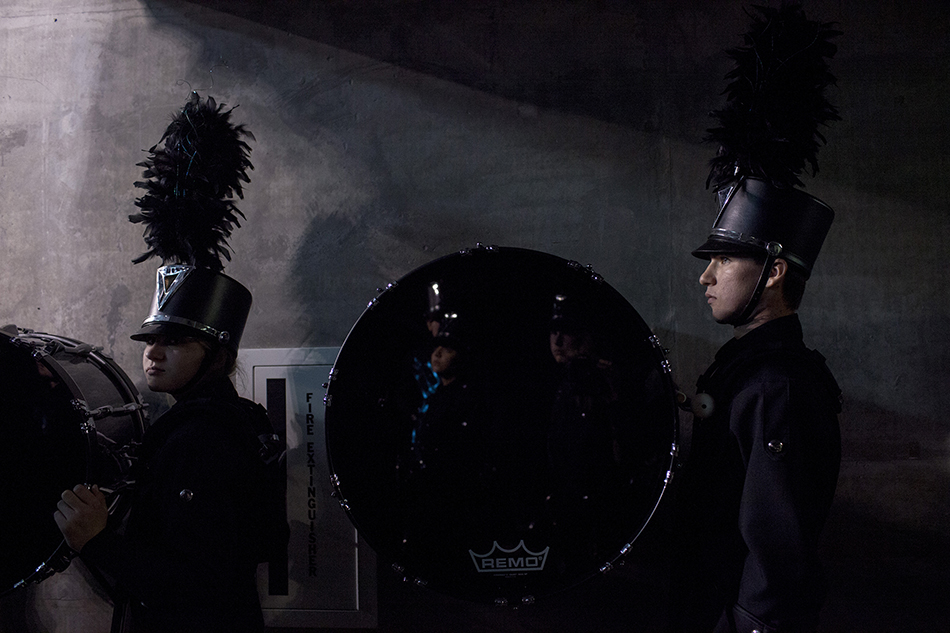
TID:
Thanks for being open to this, Caitlin. This image is a lovely image. Can you tell us the backstory?
CAITLIN:
I'm thrilled to be invited to contribute. Thank you. The ISSMA marching band finals are held at Lucas Oil Stadium. It was high energy and emotional for the bands; any way the results came back, it was their last performance together as a high school band. It felt big league for the students, but also for me as an intern. The difference is that most of them had been to the competition before and I hadn't. The Herald covers this event annually, and one of our Dubois County bands almost certainly wins in their respective divisions. We were planning a double truck photo spread and a large gallery for the following Monday so I knew that I needed a variety of strong moments. This year I was covering Forest Park High School in Class D and Jasper High School in Class B. Forest Park was hot off of two previous state championships in '12 and '13, as well as six other state titles since 1981. Counting this year, Jasper had been invited to the finals 24 years in a row. The difficulty is covering two bands was that as the first was finishing performing, the other was just warming up. I had to prioritize what part of the day I would spend with them. It was fun to go through the second time and catch textures and light that I missed with the first group.
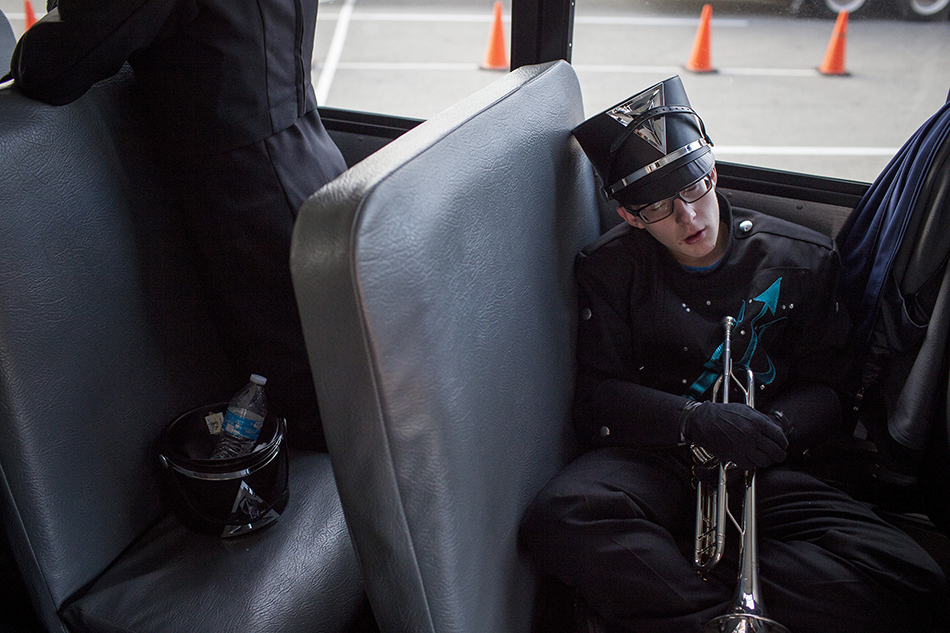
TID:
This is from an event that many of us have covered before, can you talk about your desire to see around the edges of an event?
CAITLIN:
I suspected that the performances themselves were going to be short, and the action shots likely wouldn't tell the story of what the musicians were really going through: nerves, hope, elation, disappointment, etc. I spoke with the fine team at The Herald before driving up to Indianapolis about what parts of the day were likely to be the most emotional and interesting to make pictures during. I'm more interested in quiet moments and expressions of genuine emotion.
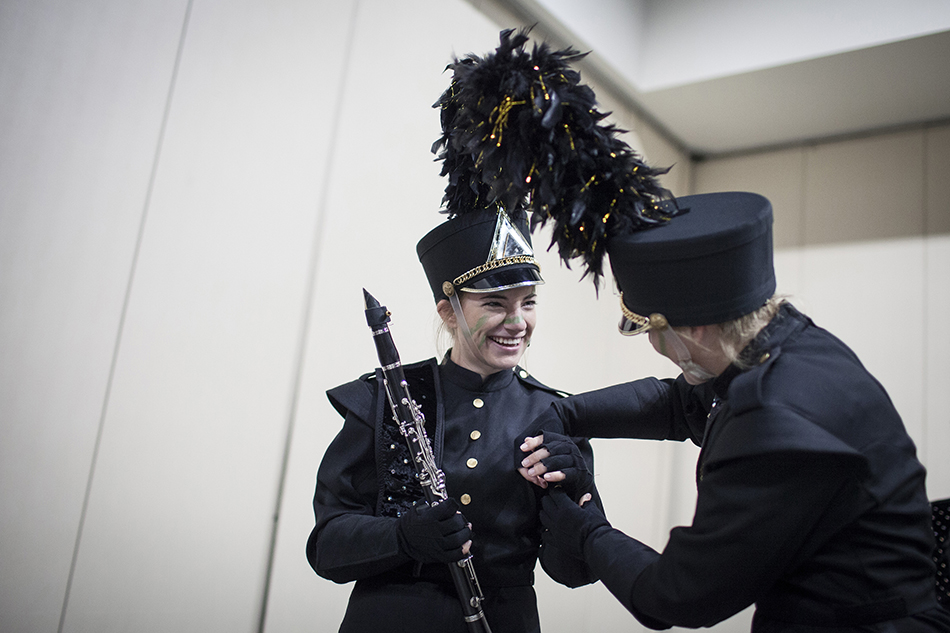
These kids ran the gamut of emotional expression throughout the day, from sadness of seniors realizing they wouldn't play together again to waiting for the results on the field. All of that seemed more storytelling than their game faces and choreography, albeit nearly flawless. I had also seen beautiful coverage of the event by Herald photojournalists in the past, so I knew I had to step it up because the community expects a high level of storytelling.
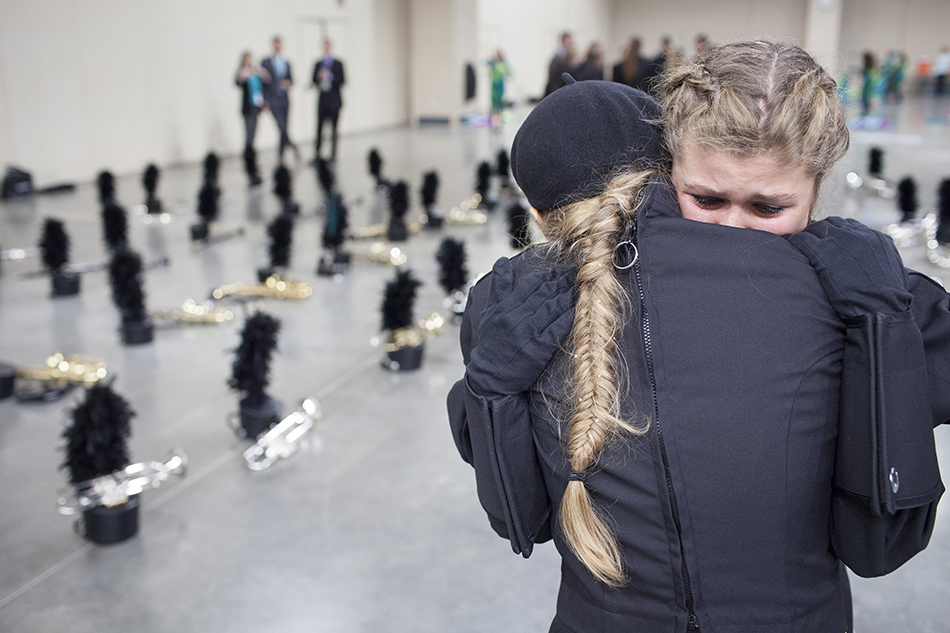
TID:
When you first identified the scene how did you positions yourself to make the image, what were you specifically looking for?
CAITLIN:
I made this picture when I was waiting with Forest Park in the tunnel before they took the field. The light coming in was dramatic and the marching band uniforms were making interesting layers so I was playing with that when I noticed Olivia and Austin with their bass drums. I wanted to capture the anticipation and the professionalism of the band. I would be lying if I said it wasn't a gift of light, though.
TID:
What challenges did you encounter while working to making these images, especially at the beginning?
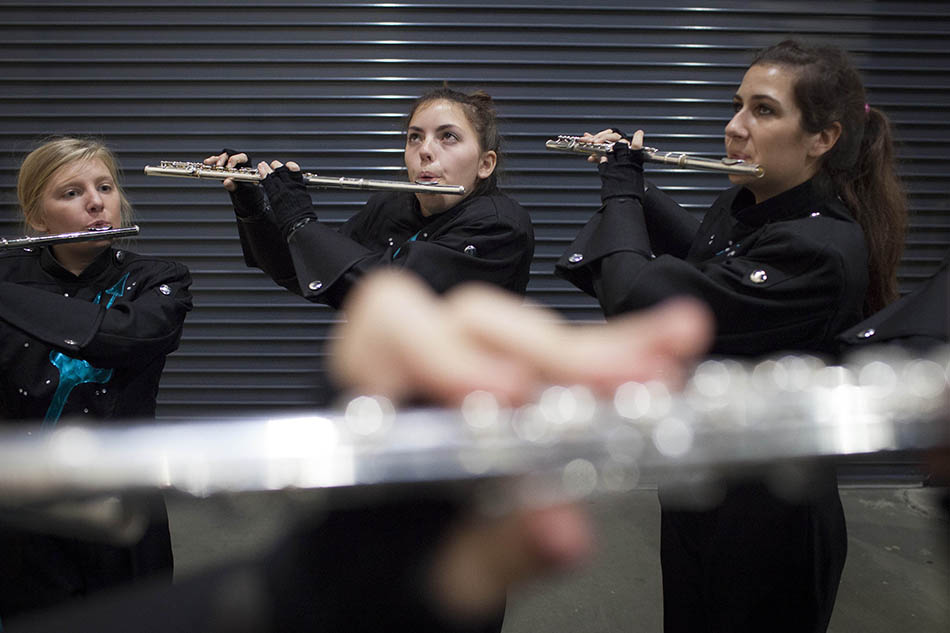
CAITLIN:
The most challenging part was deciding which parts of the day to skip when I had to meet the other band or stop to file images for the web. That was when the meetings I had beforehand really helped. I felt well prepared and armed with advice, even when I was running from one side of the stadium to the other or sneaking in protein bars.
I felt overwhelmed about getting names when everyone was in uniform. Dubois County is made up of tight-knit communities, and it feels extra awful to misidentify a source. This was an important day for them and I wanted to document it to my best ability.
TID:
How did you handle and overcome these problems? And can you also talk about your execution technically of the images?
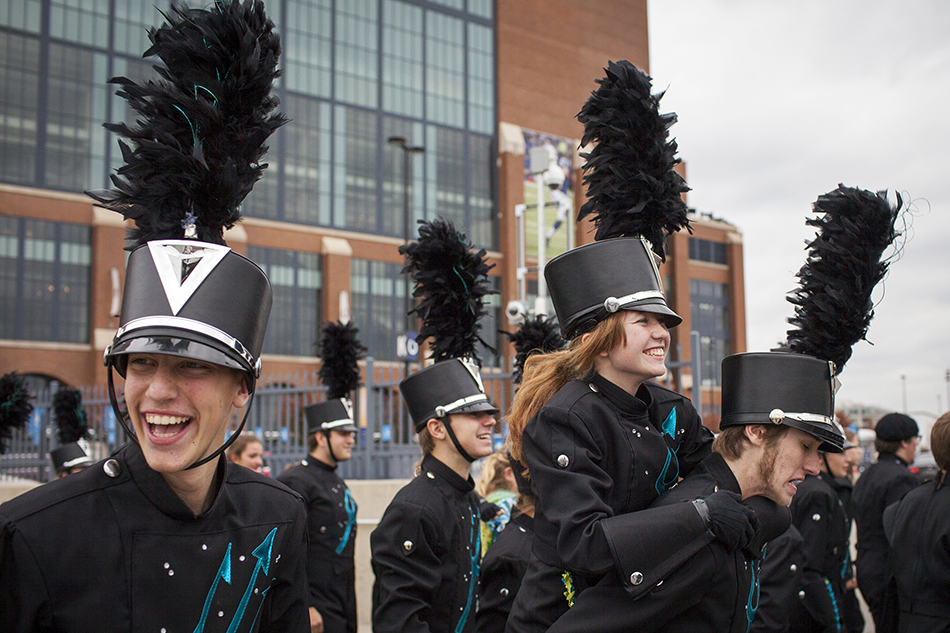
CAITLIN:
Luckily, I had spent all morning with the band, making pictures of them napping on the bus and warming up, so they were comfortable around me and didn't feel threatened.
For the names, Dave Weatherwax advised me to collect as many as I could during warm ups when it would be easier to identify faces and take closeups and to shoot wider shots of the performance. And then, at the advice of Rachel Mummey, I took the drum majors' cell numbers from each band to picture message them when I was fact-checking. The paper wanted to make a gallery of 40 pictures and I did end up having a name error go to print (I got immediately called out by a mom on Facebook!), but that's just something I will take forward and learn from. It was a punch in the gut, but other than that I was proud of the work I did after a long day.
I was shooting with two camera bodies with a 70-200 and a 35mm prime for most of the day. I have a habit of defaulting to that setup because it makes me think in two distinct ways: moving with my feet and also compressing layers to make clean images. Originally I took the bass drum image with the long lens from the other side of the tunnel, but I pushed through the crowd and made the final image on my prime. I widened the depth of field to make sure both students would be sharp and noticed that the concrete wall's texture added a layer that I liked. I moved around until I found the spot that worked.
TID:
Now, onto the moment. Can you tell us specifically what was going on both here and in your mind leading up to the picture?
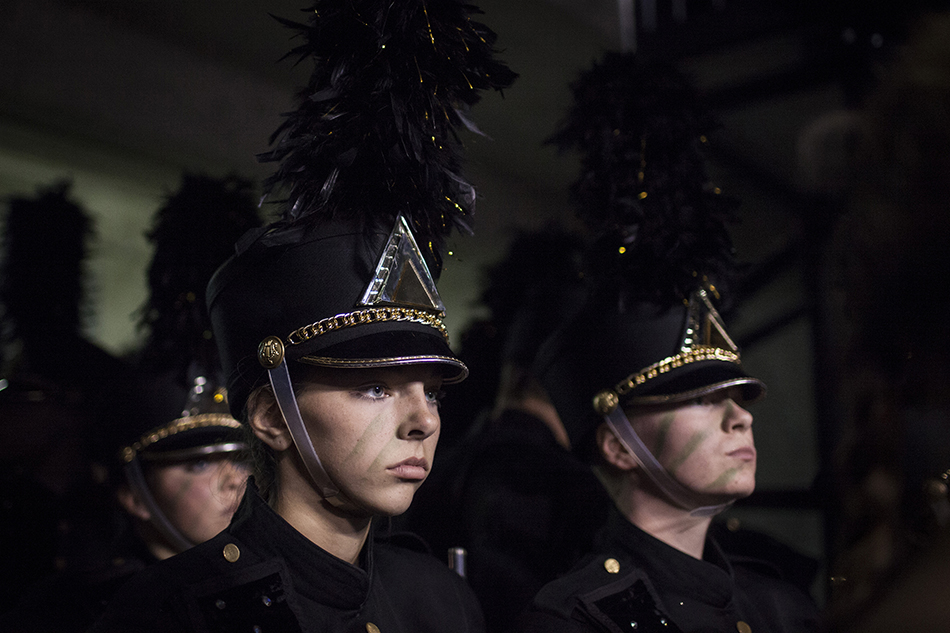
CAITLIN:
We were moved from the practice room to the tunnel where the football players enter the field. They were feeling confident but each seemed to be reflective and going over small details in their minds. I was trying to make pictures but not disturb them too much or break their focus. I had to adjust the exposure because I was being reflected in the drum along with the other band members. But I glanced at it in camera and knew I wanted the image. I was squatting all over the place, hiding behind plumes and uniforms, and the kids kind of noticed and were teasing me. It came together within a minute of when we entered the field, but I kept shooting and fighting the temptation to check if I got it. I ran out to photograph them entering and continued with the coverage. I finally saw the image a few hours later and it was the first one I sent back to Jasper.
TID:
What surprised you about the main image? What has surprised you about the making of these images with this group of people?
CAITLIN:
It came out of camera looking moody and painterly, which shocked me. I got really lucky with the quality of light.I was also surprised at how quickly I went from an invader of high-school personal space in the morning to being invited into hugs and tears by the end. It was a really fun shoot and I'm glad I was able to experience the full day with each band.
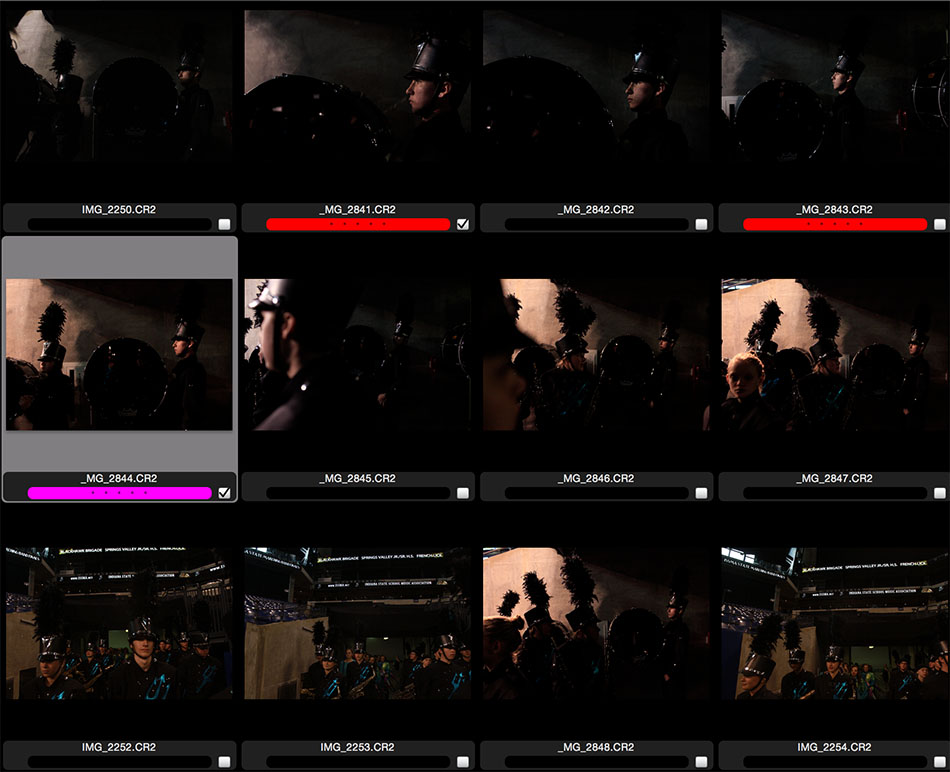
TID:
What have you learned about yourself in the process of making these images?
CAITLIN:
My nature is often timid and I'm quite scatterbrained, so I had to push myself to engage many people and stay on top of my schedule. I think I showed myself that I can work best when I don't let myself get overwhelmed, but focus instead on preparing well, having fun and work efficiently. I challenged myself to get closer in proximity to the sources and empathized with their experience and that made better pictures.
TID:
What have you learned about others, about how to push the bounds of a normal assignment?
CAITLIN:
People are always freaked out by cameras, but they really do want the community to know their story. In this case, it was how hard these kids worked and how passionate they were. I'm surprised every day I'm not turned away from sources. I think the oft-told maxims of asking for more access and staying longer always amplify a shoot or a story. For example, I arrived around the same time that Forest Park did, but they were waiting on the bus. I asked to board it with them for a few moments and caught a few people napping with their instruments. I might not have thought to look for that before I had the mindset of shooting the event with a story arc.
We are often afforded more time at The Herald to work events like this, and I only had two bands to cover, regardless of who won. Other journalists there were trying to shoot every performance to ensure they got the winners. In that way, I was simply fortunate. But even still, I believe it's always possible to get under the skin of an assignment and be there for more genuine or behind-the-scenes moments. It takes planning and a lot of energy to cover a big event more intimately, but it's much more rewarding for me.

TID:
In conclusion, what advice do you have for photographers?
CAITLIN:
I'm still looking for a lot of advice myself. But I think what I can contribute is to be genuine and curious about your stories and sources. I'm learning to ask tougher questions and be a more thorough reporter. Take great notes and if you're questioning whether you need a name of that person or not, get the damn name.
:::BIO:::

Caitlin O'Hara (b. 1992) aims to show what we have in common through visual storytelling. She's an alumna of the Indiana University School of Journalism ('14) and the Indiana Daily Student. Through January, she is learning with the Dubois County Herald. Then she will travel to Seoul, South Korea for a reporting trip funded by the Ross Hazeltine Travel Scholarship. She's interested in community storytelling and projects that deal with memory and mental health. When she's not making pictures, she's likely found running in the woods, rambling about something she heard on NPR or reading science fiction.
She is on Instagram: @caitlin_oh and Twitter: @caitlin_oh
Her work can be found at www.caitlinohara.com.